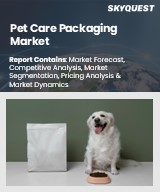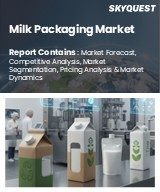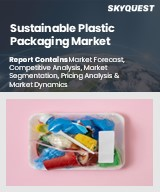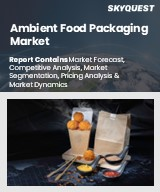
|
시장보고서
상품코드
1822482
세계의 경질 포장 시장 : 예측 - 제품 유형별, 재료별, 생산 공정별, 유통 채널별, 최종 사용자별, 지역별 분석(-2032년)Rigid Packaging Market Forecasts to 2032 - Global Analysis By Product Type, Material, Production Process, Distribution Channel, End User and By Geography |
||||||
Stratistics MRC에 따르면 세계의 경질 포장 시장은 2025년에 4,783억 달러로 추정되고, 예측 기간 동안 CAGR 5.6%로 성장할 전망이며, 2032년에는 7,005억 달러에 이를 전망입니다.
경질 포장은 일정한 형상과 구조를 유지하고 보관 및 운송 중에 제품을 강력하게 보호하는 용기와 소재입니다. 일반적으로 플라스틱, 유리, 금속, 골판지로 만들어져 내구성, 찌그러짐 방지, 장난 방지를 보장합니다. 이 유형의 포장은 제품 무결성과 선반에 진열이 중요한 식품, 의약품 및 소비재와 같은 업계에서 널리 사용됩니다. 단단한 포장은 또한 주문을 받아서 만들어질 수 있는 디자인과 라벨링 표면에 의하여 브랜딩을 지원합니다.
편의성 향상 및 소비자 라이프스타일 변화
단단한 포장은 내구성, 취급 용이성, 우수한 보호 기능을 제공하며 이동 중에 소비 및 장기 보존 가능한 제품에 이상적입니다. 빨리 먹을 수 있는 식사, 병입 음료, 퍼스널케어 아이템을 선택하는 소비자가 늘어남에 따라, 병, 보틀, 용기 등의 경질 포맷에 대한 수요는 증가의 길을 따라가고 있습니다. 또한 조직화된 소매업 및 전자상거래 플랫폼의 성장으로 운송 중 제품의 무결성을 보장하는 패키징에 대한 요구가 커지고 있습니다.
환경에 대한 배려 및 규제
각 지역의 규제 기관은 포장 폐기물에 대한 기준을 엄격히 하고 있으며, 제조업체는 재료의 선택과 생산 공정의 재검토를 강요받고 있습니다. 지속가능성에 관한 법규를 준수하기 위해서는 재활용 가능한 대체품이나 퇴비화 가능한 대체품에 대한 투자가 필요한 경우가 많아 운영비가 높아질 수 있습니다. 게다가 여론의 압력과 환경보호 활동은 기업의 책임에 영향을 미치고 브랜드는 보다 환경친화적인 관행을 채택할 수밖에 없습니다.
신흥국 시장 개발
가처분 소득 증가 및 중류 계급 인구 확대가 고급 포장 및 보호 포장 형식의 채용을 뒷받침하고 있습니다. 지방 정부도 인프라와 제조 능력에 투자하고 있으며 시장 진입과 확대에 유리한 조건을 창출하고 있습니다. 이러한 성장 잠재력은 세계 기업의 지역 생산 기지와 유통망 구축을 뒷받침하고 있습니다. 이와 같이 신흥국에서는 급속한 산업화 및 도시화가 진행되고 있어 포장 상품의 소비 확대로 이어지고 있습니다.
대체 소재 개발
유연한 형식은 비용 효율성, 경량 특성 및 재료 사용량을 줄이고 지속가능성과 물류의 이점을 추구하는 제조업체에게 매력적입니다. 게다가 산업계가 미니멀리즘과 환경 친화적인 패키징으로 축발을 옮기고 있기 때문에 경질 포맷은 새로운 기대에 부응할 수 있도록 진화하지 않는 한, 기호성의 저하에 직면할 가능성이 있습니다. 대체 소재와의 경쟁은 격화하고 있어 성능 및 재활용성에 의한 차별화가 요구되고 있습니다.
COVID-19의 영향 :
COVID-19의 대유행은 경질 포장 업계에 혼란과 호기 모두를 가져왔습니다. 초기의 봉쇄 및 공급망의 중단은 원재료의 조달과 제조 업무의 지연으로 이어졌습니다. 그러나 이 위기는 특히 식품, 건강 및 위생 분야에서 소비자의 포장 필수품에 대한 의존도를 가속화했습니다. 경질 포장은 불확실한 시기에 제품의 안전성 및 보존 안정성을 확보하는 데 중요한 역할을 했습니다. 팬데믹 후에는 위생, 편의성, 지속가능성이 중시되고, 포장의 혁신과 시장의 회복이 계속 형성되고 있습니다.
병 및 항아리 분야는 예측 기간 중 최대가 될 전망
병 및 항아리 분야는 범용성과 산업 전반에 걸친 광범위한 용도로 예측 기간 동안 최대 시장 점유율을 차지할 것으로 예측됩니다. 이 형식은 오염과 물리적 손상에 대한 탁월한 보호 기능을 제공하며 식품, 음식, 화장품 및 의약품에 적합합니다. 신선도를 유지하고 보존 기간을 연장하는 능력은 채용을 촉진하는 중요한 요소입니다. 게다가 경량 소재 및 인체 공학에 근거한 디자인의 진보가 유저 체험과 브랜드 어필을 높이고 있습니다.
예측 기간 동안 열 성형 분야의 CAGR이 가장 높아질 전망
예측 기간 동안 열 성형 분야는 비용 효과와 제품 카테고리 전체에 대한 적응성으로 인해 가장 높은 성장률을 보일 것으로 예측됩니다. 이 과정은 식품 트레이, 물집 팩 및 의료 용기에 이상적이고 정확한 치수를 가진 맞춤형 모양의 포장을 만들 수 있습니다. 이 기술은 재료 낭비를 최소화하면서 대량 생산을 지원하며 지속가능성의 목표에 부합합니다. 열 성형 가능한 바이오플라스틱과 재활용 가능한 폴리머의 기술 혁신으로 용도 분야가 더욱 넓어졌습니다.
최대 점유율을 차지하는 지역
예측 기간 동안 북미는 왕성한 소비자 수요와 첨단 제조 능력으로 최대 시장 점유율을 차지할 것으로 예측됩니다. 이 지역의 견조한 식품 및 식품 산업은 엄격한 품질 기준과 함께 신뢰할 수 있는 고성능 패키징 요구를 뒷받침합니다. 자동화 및 스마트 패키징의 기술적 진보도 시장 성장에 기여하고 있습니다. 또한 주요 기업의 존재와 지속 가능한 관행에 대한 투자는 세계 패키징 전망에서 북미의 리더십을 강화하고 있습니다.
CAGR이 가장 높은 지역 :
예측 기간 동안 아시아태평양은 급속한 도시화, 소매망 확대, 소비자 의식 증가에 힘입어 가장 높은 CAGR을 나타낼 것으로 예측됩니다. 중국, 인도, 인도네시아 등의 국가에서는 포장 상품의 소비가 증가하고 있으며, 포장 형태와 포장 재료의 혁신이 촉진되고 있습니다. 국내 제조와 환경의 지속가능성을 촉진하는 정부의 이니셔티브가 시장 개발을 더욱 가속화하고 있습니다. 이 지역의 역동적인 경제 상황과 진화하는 소비자의 선호도는 단단한 포장에 대한 투자와 전략적 확장의 핫스팟이 되었습니다.
무료 맞춤형 서비스
이 보고서를 구독하는 고객은 다음 무료 맞춤설정 옵션 중 하나를 사용할 수 있습니다.
- 기업 프로파일
- 추가 시장 기업의 종합적 프로파일링(3개사까지)
- 주요 기업의 SWOT 분석(3개사까지)
- 지역 세분화
- 고객의 관심에 응한 주요국 시장 추계, 예측 및 CAGR(주 : 타당성 확인에 따름)
- 경쟁 벤치마킹
- 제품 포트폴리오, 지리적 존재, 전략적 제휴에 기반한 주요 기업 벤치마킹
목차
제1장 주요 요약
제2장 서문
- 개요
- 이해관계자
- 조사 범위
- 조사 방법
- 데이터 마이닝
- 데이터 분석
- 데이터 검증
- 조사 접근
- 조사 자료
- 1차 조사 자료
- 2차 조사 정보원
- 전제조건
제3장 시장 동향 분석
- 성장 촉진요인
- 성장 억제요인
- 기회
- 위협
- 제품 분석
- 최종 사용자 분석
- 신흥 시장
- COVID-19의 영향
제4장 Porter's Five Forces 분석
- 공급기업의 협상력
- 구매자의 협상력
- 대체품의 위협
- 신규 참가업체의 위협
- 경쟁 기업간 경쟁 관계
제5장 세계의 경질 포장 시장 : 제품 유형별
- 용기 및 캔
- 병 및 항아리
- 박스
- 트레이 및 클램쉘
- 튜브 및 실린더
- 팔레트 및 나무 상자
- 기타 제품 유형
제6장 세계의 경질 포장 시장 : 재료별
- 플라스틱
- 폴리에틸렌테레프탈레이트(PET)
- 폴리염화비닐(PVC)
- 폴리에틸렌(PE)
- 폴리스티렌(PS)과 발포 폴리스티렌(EPS)
- 폴리프로필렌(PP)
- 기타 플라스틱
- 종이 및 판지
- 금속
- 유리
- 목재
- 기타 재료
제7장 세계의 경질 포장 시장 : 생산 공정별
- 열 성형
- 사출 성형
- 블로우 성형
- 압축 성형
- 압출
- 기타 제조 공정
제8장 세계의 경질 포장 시장 : 유통 채널별
- 직접 판매
- 유통업체 및 컨버터
- 프라이빗 라벨
- 계약 제조
- 기타 유통 채널
제9장 세계의 경질 포장 시장 : 최종 사용자별
- 식품 및 음료
- 의약품 및 헬스케어
- 퍼스널케어 및 화장품
- 가정용품
- 전기 및 전자
- 전자상거래
- 기타 최종 사용자
제10장 세계의 경질 포장 시장 : 지역별
- 북미
- 미국
- 캐나다
- 멕시코
- 유럽
- 독일
- 영국
- 이탈리아
- 프랑스
- 스페인
- 기타 유럽
- 아시아태평양
- 일본
- 중국
- 인도
- 호주
- 뉴질랜드
- 한국
- 기타 아시아태평양
- 남미
- 아르헨티나
- 브라질
- 칠레
- 기타 남미
- 중동 및 아프리카
- 사우디아라비아
- 아랍에미리트(UAE)
- 카타르
- 남아프리카
- 기타 중동 및 아프리카
제11장 주요 발전
- 계약, 파트너십, 협업 및 합작투자
- 인수 및 합병
- 신제품 발매
- 사업 확대
- 기타 주요 전략
제12장 기업 프로파일링
- Amcor Plc
- Berry Global Group, Inc.
- DS Smith Plc
- WestRock Company
- Sonoco Products Company
- Silgan Holdings Inc.
- Mondi Group
- Greif, Inc.
- Mauser Packaging Solutions
- Stora Enso Oyj
- Rengo Co., Ltd.
- ALPLA Group
- Sealed Air Corporation
- Plastipak Holdings, Inc.
- Huhtamaki Oyj
- Pactiv Evergreen Inc.
- Crown Holdings, Inc.
- AptarGroup, Inc.
- CCL Industries Inc.
- Reynolds Group Holdings Limited
According to Stratistics MRC, the Global Rigid Packaging Market is accounted for $478.3 billion in 2025 and is expected to reach $700.5 billion by 2032 growing at a CAGR of 5.6% during the forecast period. Rigid packagings are containers and materials that maintain a fixed shape and structure, offering strong protection for products during storage and transport. Commonly made from plastic, glass, metal, or cardboard, it ensures durability, resistance to crushing, and tamper prevention. This type of packaging is widely used in industries such as food, pharmaceuticals, and consumer goods, where product integrity and shelf appeal are critical. Rigid packaging also supports branding through customizable designs and labeling surfaces.
Market Dynamics:
Driver:
Increasing convenience and consumer lifestyle changes
Rigid packaging offers durability, ease of handling, and superior protection, making it ideal for on-the-go consumption and long shelf-life products. As more consumers opt for ready-to-eat meals, bottled beverages, and personal care items, the demand for rigid formats such as jars, bottles, and containers continues to rise. Additionally, the growth of organized retail and e-commerce platforms has amplified the need for packaging that ensures product integrity during transit.
Restraint:
Environmental concerns and regulations
Regulatory bodies across regions are tightening standards on packaging waste, pushing manufacturers to rethink material choices and production processes. Compliance with sustainability mandates often requires investment in recyclable or compostable alternatives, which can elevate operational costs. Moreover, public pressure and environmental activism are influencing corporate responsibility, compelling brands to adopt greener practices.
Opportunity:
Growing markets in developing regions
Rising disposable incomes and expanding middle-class populations are driving the adoption of premium and protective packaging formats. Local governments are also investing in infrastructure and manufacturing capabilities, creating favorable conditions for market entry and expansion. This growth potential is encouraging global players to establish regional production hubs and distribution networks. Thus emerging economies are witnessing rapid industrialization and urbanization, leading to increased consumption of packaged goods.
Threat:
Development of alternative materials
Flexible formats offer cost-efficiency, lightweight properties, and reduced material usage, making them attractive for manufacturers seeking sustainability and logistics advantages. Additionally, as industries pivot toward minimalistic and eco-friendly packaging, rigid formats may face declining preference unless they evolve to meet new expectations. The competition from alternative materials is intensifying, prompting the need for differentiation through performance and recyclability.
Covid-19 Impact:
The COVID-19 pandemic brought both disruption and opportunity to the rigid packaging industry. Initial lockdowns and supply chain interruptions led to delays in raw material procurement and manufacturing operations. However, the crisis also accelerated consumer reliance on packaged essentials, particularly in food, healthcare, and hygiene segments. Rigid packaging played a crucial role in ensuring product safety and shelf stability during uncertain times. Post-pandemic, the emphasis on hygiene, convenience, and sustainability continues to shape packaging innovations and market recovery.
The bottles & jars segment is expected to be the largest during the forecast period
The bottles & jars segment is expected to account for the largest market share during the forecast period due to their versatility and widespread application across industries. These formats offer excellent protection against contamination and physical damage, making them suitable for food, beverages, cosmetics, and pharmaceuticals. Their ability to preserve freshness and extend shelf life is a key factor driving adoption. Additionally, advancements in lightweight materials and ergonomic designs are enhancing user experience and brand appeal.
The thermoforming segment is expected to have the highest CAGR during the forecast period
Over the forecast period, the thermoforming segment is predicted to witness the highest growth rate driven by its cost-effectiveness and adaptability across product categories. This process allows for the creation of custom-shaped packaging with precise dimensions, ideal for food trays, blister packs, and medical containers. The technique supports high-volume production while minimizing material waste, aligning with sustainability goals. Innovations in thermoformable bioplastics and recyclable polymers are further expanding its applicability.
Region with largest share:
During the forecast period, the North America region is expected to hold the largest market share driven by strong consumer demand and advanced manufacturing capabilities. The region's robust food and beverage industry, coupled with stringent quality standards, drives the need for reliable and high-performance packaging. Technological advancements in automation and smart packaging are also contributing to market growth. Moreover, the presence of key players and investment in sustainable practices are reinforcing North America's leadership in the global packaging landscape.
Region with highest CAGR:
Over the forecast period, the Asia Pacific region is anticipated to exhibit the highest CAGR fueled by rapid urbanization, expanding retail networks, and rising consumer awareness. Countries like China, India, and Indonesia are experiencing increased consumption of packaged goods, prompting innovation in packaging formats and materials. Government initiatives promoting domestic manufacturing and environmental sustainability are further accelerating market development. The region's dynamic economic landscape and evolving consumer preferences make it a hotspot for investment and strategic expansion in rigid packaging.
Key players in the market
Some of the key players in Rigid Packaging Market include Amcor Plc, Berry Global Group, Inc., DS Smith Plc, WestRock Company, Sonoco Products Company, Silgan Holdings Inc., Mondi Group, Greif, Inc., Mauser Packaging Solutions, Stora Enso Oyj, Rengo Co., Ltd., ALPLA Group, Sealed Air Corporation, Plastipak Holdings, Inc., Huhtamaki Oyj, Pactiv Evergreen Inc., Crown Holdings, Inc., AptarGroup, Inc., CCL Industries Inc. and Reynolds Group Holdings Limited.
Key Developments:
In April 2025, Mondi acquired Schumacher Packaging's Western Europe assets. The deal adds 1B sqm of capacity and expands solid board solutions.
In April 2025, Amcor merged with Berry Global in an all-stock deal. The combination creates a packaging giant with $650M in synergies and boosts EPS by 12% in FY26.
In January 2025, DS Smith was acquired by International Paper for $18.6B. The deal adds $514M in synergies and strengthens sustainable packaging leadership.
Product Types Covered:
- Containers & Cans
- Bottles & Jars
- Boxes
- Trays & Clamshells
- Tubes & Cylinders
- Pallets & Crates
- Other Product Types
Materials Covered:
- Plastic
- Paper & Paperboard
- Metal
- Glass
- Wood
- Other Materials
Production Processes Covered:
- Thermoforming
- Injection Molding
- Blow Molding
- Compression Molding
- Extrusion
- Other Production Processes
Distribution Channels Covered:
- Direct Sales
- Distributors & Converters
- Private Label
- Contract Manufacturing
- Other Distribution Channels
End Users Covered:
- Food & Beverages
- Pharmaceuticals & Healthcare
- Personal Care & Cosmetics
- Household Products
- Electrical & Electronics
- E-commerce
- Other End Users
Regions Covered:
- North America
- US
- Canada
- Mexico
- Europe
- Germany
- UK
- Italy
- France
- Spain
- Rest of Europe
- Asia Pacific
- Japan
- China
- India
- Australia
- New Zealand
- South Korea
- Rest of Asia Pacific
- South America
- Argentina
- Brazil
- Chile
- Rest of South America
- Middle East & Africa
- Saudi Arabia
- UAE
- Qatar
- South Africa
- Rest of Middle East & Africa
What our report offers:
- Market share assessments for the regional and country-level segments
- Strategic recommendations for the new entrants
- Covers Market data for the years 2024, 2025, 2026, 2028, and 2032
- Market Trends (Drivers, Constraints, Opportunities, Threats, Challenges, Investment Opportunities, and recommendations)
- Strategic recommendations in key business segments based on the market estimations
- Competitive landscaping mapping the key common trends
- Company profiling with detailed strategies, financials, and recent developments
- Supply chain trends mapping the latest technological advancements
Free Customization Offerings:
All the customers of this report will be entitled to receive one of the following free customization options:
- Company Profiling
- Comprehensive profiling of additional market players (up to 3)
- SWOT Analysis of key players (up to 3)
- Regional Segmentation
- Market estimations, Forecasts and CAGR of any prominent country as per the client's interest (Note: Depends on feasibility check)
- Competitive Benchmarking
- Benchmarking of key players based on product portfolio, geographical presence, and strategic alliances
Table of Contents
1 Executive Summary
2 Preface
- 2.1 Abstract
- 2.2 Stake Holders
- 2.3 Research Scope
- 2.4 Research Methodology
- 2.4.1 Data Mining
- 2.4.2 Data Analysis
- 2.4.3 Data Validation
- 2.4.4 Research Approach
- 2.5 Research Sources
- 2.5.1 Primary Research Sources
- 2.5.2 Secondary Research Sources
- 2.5.3 Assumptions
3 Market Trend Analysis
- 3.1 Introduction
- 3.2 Drivers
- 3.3 Restraints
- 3.4 Opportunities
- 3.5 Threats
- 3.6 Product Analysis
- 3.7 End User Analysis
- 3.8 Emerging Markets
- 3.9 Impact of Covid-19
4 Porters Five Force Analysis
- 4.1 Bargaining power of suppliers
- 4.2 Bargaining power of buyers
- 4.3 Threat of substitutes
- 4.4 Threat of new entrants
- 4.5 Competitive rivalry
5 Global Rigid Packaging Market, By Product Type
- 5.1 Introduction
- 5.2 Containers & Cans
- 5.3 Bottles & Jars
- 5.4 Boxes
- 5.5 Trays & Clamshells
- 5.6 Tubes & Cylinders
- 5.7 Pallets & Crates
- 5.8 Other Product Types
6 Global Rigid Packaging Market, By Material
- 6.1 Introduction
- 6.2 Plastic
- 6.2.1 Polyethylene Terephthalate (PET)
- 6.2.2 Polyvinyl Chloride (PVC)
- 6.2.3 Polyethylene (PE)
- 6.2.4 Polystyrene (PS) & Expanded Polystyrene (EPS)
- 6.2.5 Polypropylene (PP)
- 6.2.6 Other Plastics
- 6.3 Paper & Paperboard
- 6.4 Metal
- 6.5 Glass
- 6.6 Wood
- 6.7 Other Materials
7 Global Rigid Packaging Market, By Production Process
- 7.1 Introduction
- 7.2 Thermoforming
- 7.3 Injection Molding
- 7.4 Blow Molding
- 7.5 Compression Molding
- 7.6 Extrusion
- 7.7 Other Production Processes
8 Global Rigid Packaging Market, By Distribution Channel
- 8.1 Introduction
- 8.2 Direct Sales
- 8.3 Distributors & Converters
- 8.4 Private Label
- 8.5 Contract Manufacturing
- 8.6 Other Distribution Channels
9 Global Rigid Packaging Market, By End User
- 9.1 Introduction
- 9.2 Food & Beverages
- 9.3 Pharmaceuticals & Healthcare
- 9.4 Personal Care & Cosmetics
- 9.5 Household Products
- 9.6 Electrical & Electronics
- 9.7 E-commerce
- 9.8 Other End Users
10 Global Rigid Packaging Market, By Geography
- 10.1 Introduction
- 10.2 North America
- 10.2.1 US
- 10.2.2 Canada
- 10.2.3 Mexico
- 10.3 Europe
- 10.3.1 Germany
- 10.3.2 UK
- 10.3.3 Italy
- 10.3.4 France
- 10.3.5 Spain
- 10.3.6 Rest of Europe
- 10.4 Asia Pacific
- 10.4.1 Japan
- 10.4.2 China
- 10.4.3 India
- 10.4.4 Australia
- 10.4.5 New Zealand
- 10.4.6 South Korea
- 10.4.7 Rest of Asia Pacific
- 10.5 South America
- 10.5.1 Argentina
- 10.5.2 Brazil
- 10.5.3 Chile
- 10.5.4 Rest of South America
- 10.6 Middle East & Africa
- 10.6.1 Saudi Arabia
- 10.6.2 UAE
- 10.6.3 Qatar
- 10.6.4 South Africa
- 10.6.5 Rest of Middle East & Africa
11 Key Developments
- 11.1 Agreements, Partnerships, Collaborations and Joint Ventures
- 11.2 Acquisitions & Mergers
- 11.3 New Product Launch
- 11.4 Expansions
- 11.5 Other Key Strategies
12 Company Profiling
- 12.1 Amcor Plc
- 12.2 Berry Global Group, Inc.
- 12.3 DS Smith Plc
- 12.4 WestRock Company
- 12.5 Sonoco Products Company
- 12.6 Silgan Holdings Inc.
- 12.7 Mondi Group
- 12.8 Greif, Inc.
- 12.9 Mauser Packaging Solutions
- 12.10 Stora Enso Oyj
- 12.11 Rengo Co., Ltd.
- 12.12 ALPLA Group
- 12.13 Sealed Air Corporation
- 12.14 Plastipak Holdings, Inc.
- 12.15 Huhtamaki Oyj
- 12.16 Pactiv Evergreen Inc.
- 12.17 Crown Holdings, Inc.
- 12.18 AptarGroup, Inc.
- 12.19 CCL Industries Inc.
- 12.20 Reynolds Group Holdings Limited



















